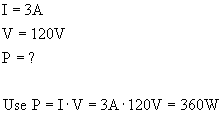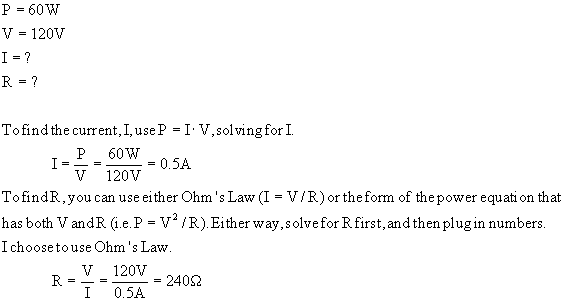Power
Power, in general, is defined as the rate at which energy is being used. How that energy is being used can vary: it could be going into useful work, or maybe just being turned into heat, or both. Recall that rate means divided by time.
![]()
So the units used to measure power would be the unit of energy (the Joule, in SI) divided by a unit of time (usually we use seconds). The unit J/sec has been given a special name: the Watt (abbreviated W.)
to do as you read
In electronics, the current that flows through a circuit experiences resistance, and that causes the wires of the circuit to heat up. Usually, that's where most of the energy goes, into waste heat. Some, however, may go into useful work, such as running a motor. Either way, we can relate the power used with the amount of current flowing through the circuit, and amount of voltage that is pushing that current. Recall that current is charge per time, and voltage is energy per charge:
![]()
![]()
Notice that if you multiply I times V, you get this:
![]()
So, we can write a general equation for power in electric circuits:
![]()
We can use Ohm's Law to substitute for I or V, giving alternative versions of the power equation.

EXAMPLE: How much power does a projector use, if its label says it draws 3 amps (when plugged into a standard U.S. electrical outlet)?

EXAMPLE: The spec label on a lightning globe I have says it uses 18W of power. It plugs into a standard wall outlet. What current must flow through it?
EXAMPLE: How much current does a 60-Watt lightbulb draw, and what is its resistance?
3. Let's say you have a circuit that needs a 470 Ω resistor across 12 volts. What power must that resistor be able to absorb? Are you going to choose a 1/4W resistor, or 1/2W? Solution video
4. You have a 1/2-Watt, 220 Ω resistor. What is the greatest voltage you can connect it to without risking a fire? Solution video
5. The video link above shows a 1/4-Watt, 1.0 Ω resistor connected to 12 volts. Calculate what power is it absorbing. It can only safely absorb 0.25 W, so (if you do the calculation correctly) you'll understand why it caught fire! Solution video
Additional Activities & Practice
6. If three unequal resistances are wired in parallel, which one will use the most power? To be specific, let's say they are 2000, 9000, and 15000-ohm resistors.
7. If three unequal resistances are wired in series, which one will use the most power? To be specific, let's say they are 2000, 9000, and 15000-ohm resistors.
8. Once you have finished problems 6 and 7, watch this video.

